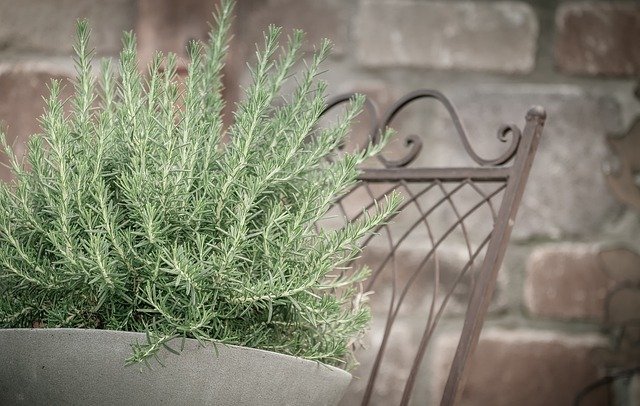Last updated on October 10th, 2023 at 07:06 am
Few plants can add as much life and color to a room as a mini palm tree house plant. Mini palm tree plants are perfect for indoor use, as they thrive in warm, sunny environments. Indoor mini palm trees can be used to brighten up any room in your home and make a great addition to any décor.
Some popular mini palm tree houseplants are Lady Palm, Chinese Fan Palm, Areca Palm, Dwarf Palmetto, Majestic Palm, Bamboo Palm, Cascade Palm, Parlor Palm, Parlor Palm, Ponytail Palm, European Fan Palm, Sago Palm, Yucca Palm, Miniature Fishtail Palm, Pygmy Date Palm, Chamaedorea atrovirens, Dwarf Sugar Palm, Dwarf Mountain Palm, Kentia Palm, and Bottle Palm.
Table of Contents
Types of mini palm trees for houseplants:
Lady Palm (Rhapis excelsa)
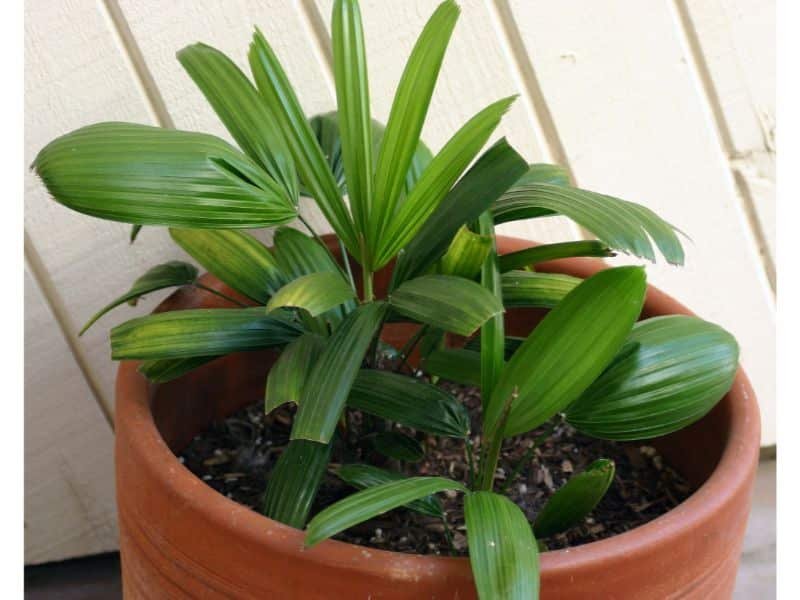
Lady Palm (Rhapis excelsa) is an excellent choice for indoor spaces for several compelling reasons. Its adaptability to low light conditions, coupled with its air-purifying qualities, makes it ideal for environments with limited natural sunlight and a desire for cleaner indoor air. Furthermore, Lady Palms are low-maintenance, drought-tolerant, and resistant to common indoor plant pests and diseases, simplifying care for indoor gardeners.
With their elegant, fan-shaped leaves, they enhance the aesthetic appeal of indoor spaces while being pet-friendly and adaptable to a range of temperatures and humidity levels. Their longevity and durability make them a long-lasting and visually pleasing addition to any indoor setting.
Chinese Fan Palm (Livistona chinensis)
The Chinese fan palm (Livistona Chinensis) is a species of palm tree that is native to southern China, where it grows in moist subtropical and tropical forests. This palm is an excellent choice for indoor use, as it thrives in warm, sunny environments. The Chinese fan palm can be used to brighten up any room in your home and make a great addition to any décor.

The taking care process of this mini palm is not as difficult as you might think. It requires well-drained soil and does not tolerate standing water. The Chinese fan palm should be watered regularly, but allowed to dry out between watering.
The Chinese fan palm can grow to a height of 20 feet (6 meters) and a width of 10 feet (3 meters).
Areca Palm (Dypsis lutescens)
The areca palm, also known as the golden cane palm, is a species of palm tree that is native to Southeast Asia. This palm is an excellent choice for indoor use, as it thrives in warm, sunny environments. The areca palm is a fast-growing plant and can reach heights of up to 20 feet tall.

The miniature version of this palm tree is perfect for indoor use, as it only grows to be about 3-4 feet tall. The mini areca palm tree is a slow grower, so it will not need to be repotted as often as its larger counterpart.
This palm tree is known for its beautiful, bright green leaves, which can add a touch of tropical flair to any room. The areca palm is also relatively easy to care for and only requires occasional watering and misting.
Dwarf Palmetto (Sabal minor)
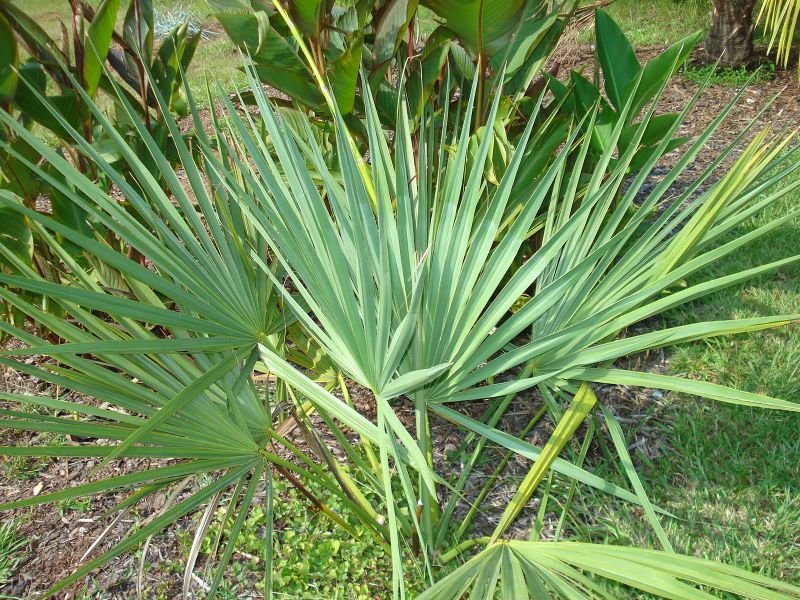
Dwarf Palmetto (Sabal minor) is a captivating palm species native to the southeastern United States, prized for its small size and unique features. Standing at a modest height of 3 to 6 feet with a similar spread, it’s ideal for compact garden spaces and even container gardening.
What sets this palm apart is its exceptional cold hardiness, able to withstand freezing temperatures for short periods, making it a favorite in regions with occasional frost. Its fan-shaped, bluish-green leaves and short trunk covered in leaf bases give it a distinct, attractive appearance. This low-maintenance palm thrives in a variety of soil types, from sandy to well-draining, and is drought-tolerant once established.
While it can tolerate some shade, it prefers full sun to partial shade, making it versatile for various garden settings. Dwarf Palmetto can be used as ground cover, border plant, or a charming focal point, attracting wildlife with its fruit and adding a touch of the tropics to landscapes or container gardens.
Majestic Palm (Ravenea rivularis)
Majestic Palm (Ravenea rivularis) is a mini palm tree house plant that can be grown indoors. This palm tree is known for its slender trunk and feathery green leaves. Majestic Palm grows best in bright, indirect light and moist but well-drained soil. Allow the top inch of soil to dry out between watering.
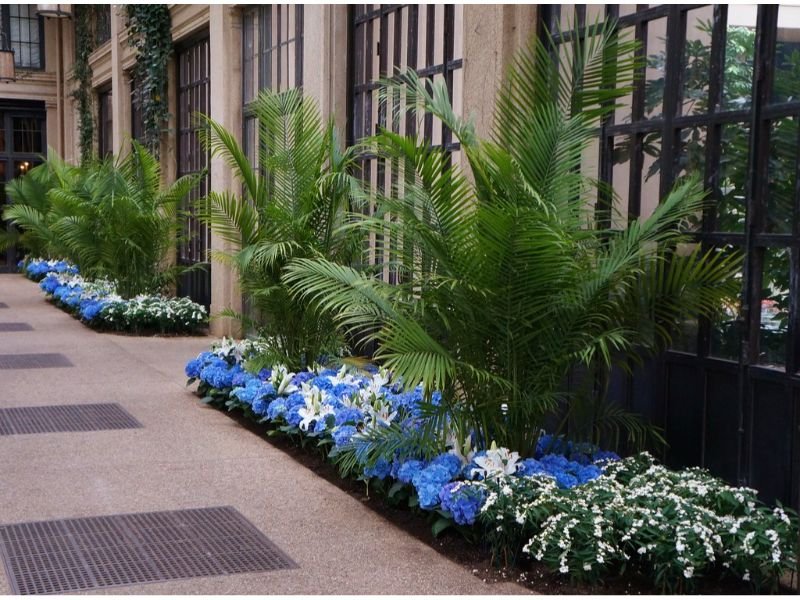
fertilizer every two weeks during the growing season. Keep the palm tree’s environment humid by misting it with water or placing the pot on a pebble tray filled with water. Majestic Palm is an evergreen tree and can grow up to 20 feet tall.
The small Majestic Palm tree is perfect for indoor as it can grow only up to 6 feet. It is also known as the mini indoor palm tree.
This palm tree is a great air purifier and can help improve indoor air quality.
Bamboo Palm (Chamaedorea seifrizii)
The Bamboo Palm (Chamaedorea seifrizii), also known as the Reed Palm, is a favored indoor plant admired for its graceful appearance and air-purifying qualities. Its slender, bamboo-like fronds create an elegant, tropical ambiance in indoor spaces, making it a popular choice for home and office environments.
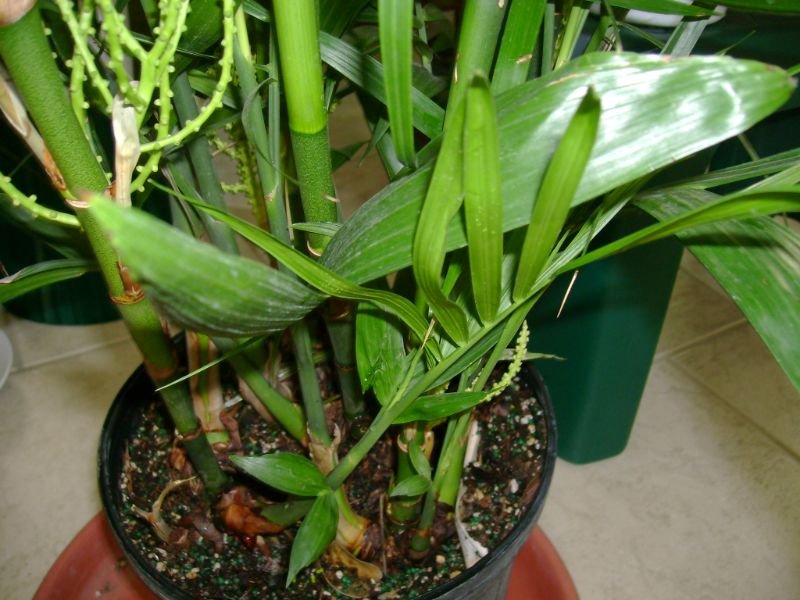
Notably, Bamboo Palms excel at improving indoor air quality by filtering out common household pollutants, such as formaldehyde and benzene. Their ability to thrive in low to moderate light conditions, coupled with their low-maintenance requirements, makes them ideal for areas with limited sunlight and for busy individuals seeking an attractive yet hassle-free plant.
These palms, standing at a manageable height of 4 to 6 feet indoors, can fit comfortably in various decorative containers and are pet-friendly, making them an all-around excellent addition to interior decor and indoor plant collections.
Cascade Palm (Chamaedorea cataractarum)
The cascade palm (Chamaedorea cataractarum) is a small, slow-growing palm that makes an excellent houseplant. It has feathery leaves and grows slowly, so it is perfect for small spaces.

Cascade palms do best in bright, indirect light and can tolerate a wide range of temperatures. They are not particularly drought tolerant, so be sure to water them regularly. Cascade palms are susceptible to root rot, so be sure to plant them in well-draining soil.
Cascade Palm is well-known for its benefit of removing indoor air toxins, making it a great choice for an indoor palm.
Parlor Palm (Chamaedorea elegans)
The mini parlor palm is a small, but striking houseplant that can be a great addition to any room. This palm tree has dark green leaves with a feathery texture that makes it stand out from other plants. Plus, it’s easy to care for and doesn’t require much sunlight or water to stay healthy.

In terms of longevity, the dwarf version of this palm tree can live up to 50 years if properly taken care of, making it a great plant to invest in for the long term.
Ponytail Palm (Beaucarnea recurvata)
The Ponytail Palm is a unique-looking plant that can make a great addition to any home. It’s perfect for indoor use and doesn’t require a lot of maintenance, making it a great option for those who don’t have a lot of time to spend on plants. Plus, it’s really easy to care for – just water it regularly and keep it in a bright spot.
Regular watering here is approximately 2x per week.
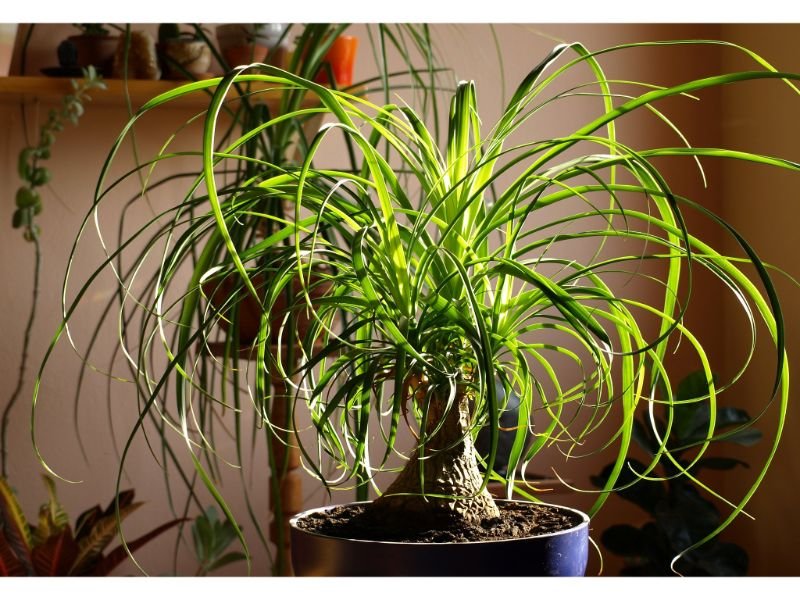
The Ponytail Palm is a slow grower, so it won’t get too big for its pot. However, if you want to keep it looking its best, you should re-pot it every few years. Just make sure to use a well-draining potting mix and a pot that’s only slightly larger than the plant.
Other than that, this plant is pretty low-maintenance and can tolerate a wide range of conditions. Just make sure to keep it out of the direct sun, as it can scorch the leaves. If you do that, your Ponytail Palm will be happy and thrive for years to come!
European Fan Palm (Chamaerops humilis)
The European Fan Palm (Chamaerops humilis) is not commonly chosen as a houseplant due to its size and outdoor preferences, but it can be adapted for indoor growth under specific conditions.
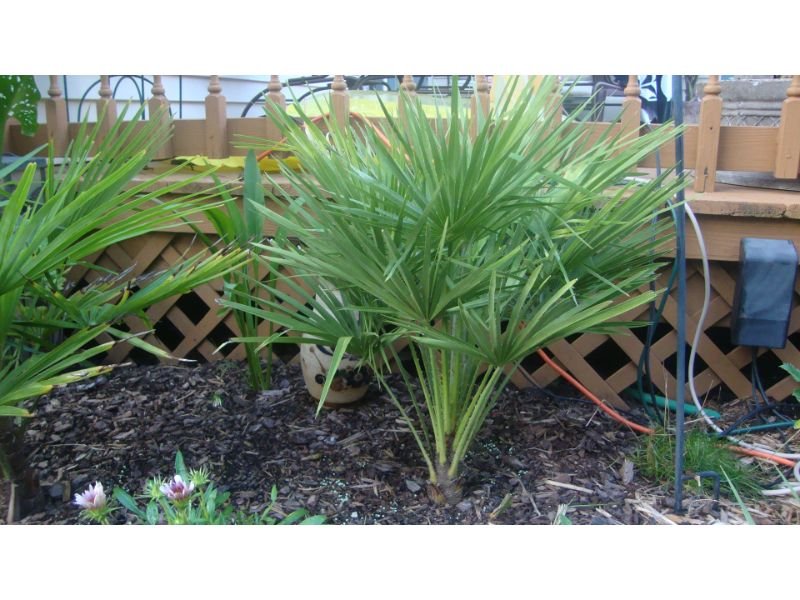
One of the main reasons it can make a suitable houseplant is its unique aesthetic appeal—its fan-shaped fronds and multiple stems can serve as an exotic focal point, adding an elegant touch to indoor decor.
Another advantage is its tolerance for lower light conditions, although it won’t grow as vigorously indoors as it would outdoors. European Fan Palms can endure cooler indoor temperatures, making them an option for homes in regions with colder winters.
They also contribute to improved indoor air quality by filtering pollutants and increasing humidity, and their compact size allows for container cultivation. While they require some maintenance, including well-draining soil, moderate watering, and occasional pruning, they can be a distinctive and manageable addition to indoor greenery when given proper care.
It’s important to note that while European Fan Palms can be grown indoors, they are best suited for outdoor cultivation in Mediterranean-like climates. When growing them indoors, you should provide as much natural sunlight as possible, such as placing them near a south-facing window, and be prepared for slower growth compared to outdoor conditions.
Additionally, they may benefit from occasional outdoor exposure during warmer months to promote their overall health and vigor.
Sago Palm (Cycas revoluta)
Sago palm is unique among palm trees because it can be grown as a house plant. It is also one of the few palms that can tolerate cold weather. If you live in an area that gets cold winters, you can grow sago palms indoors.

Sago palm is a slow-growing plant that can reach a height of 6 to 10 feet. It has long, narrow leaves that are arranged in a spiral pattern. The leaves are dark green and have a leathery texture. The flowers are small and yellow, and they are borne on cones that are produced by the female plant. The fruit is a small, black drupe.
Sago palm is native to Japan and Korea. It is frequently grown as an ornamental plant in other parts of the world.
If you want to grow sago palm as a house plant, it is important to choose a dwarf variety. Dwarf varieties of sago palm are available from nurseries and garden centers. They typically grow to a height of 3 to 5 feet.
When growing sago palm as a house plant, it is important to provide bright light. The plant will do best in a south-facing window. If you cannot provide bright light, you can grow sago palms under fluorescent lights.
Water sago palm when the top inch of soil is dry. Allow the plant to dry out slightly between watering. During the winter months, water sago palms less frequently. Fertilize sago palm monthly during the growing season with a balanced fertilizer. Apply fertilizer at half the recommended rate.
Sago palm is not bothered by many pests or diseases. However, mealybugs and scale can be a problem. These pests can be controlled with insecticidal soap or horticultural oil.
Yucca Palm (Yucca elephantipes)
Yucca Palm is unique because it is a small palm tree, so it is perfect for smaller spaces. It is also one of the sturdiest palms, which makes it a good choice for those who want a low-maintenance plant.
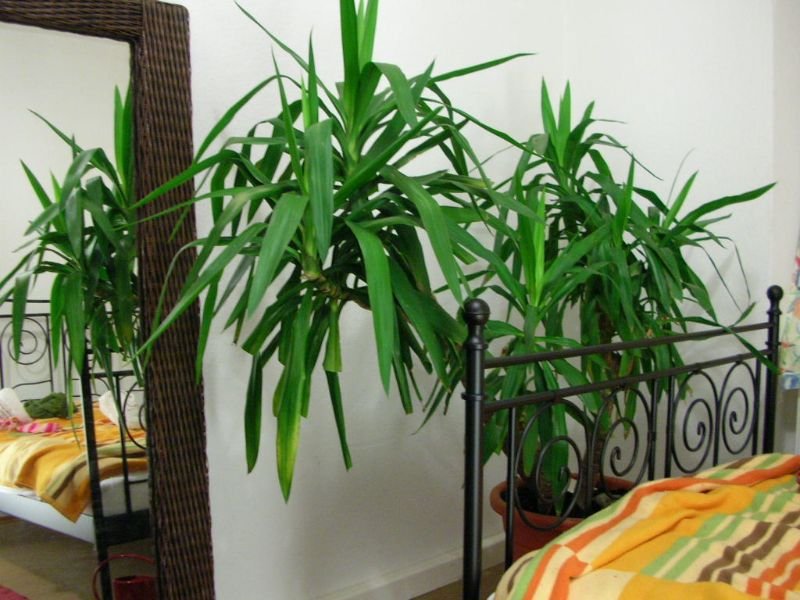
Yucca Palm does best in bright, indirect light but can also tolerate low light conditions. It is important to keep the soil evenly moist, but not wet or soggy. Allow the top inch of soil to dry out in between watering.
Yucca Palm is not susceptible to many pests or diseases, but it can be sensitive to fluoride. If you notice the tips of the leaves turning brown, it is a sign that the plant is not getting enough water.
Miniature Fishtail Palm (Chamaedorea metallic)
The Miniature Fishtail Palm (Chamaedorea metallica) is a captivating and relatively small palm species known for its unique appearance and suitability as both an indoor and outdoor plant.
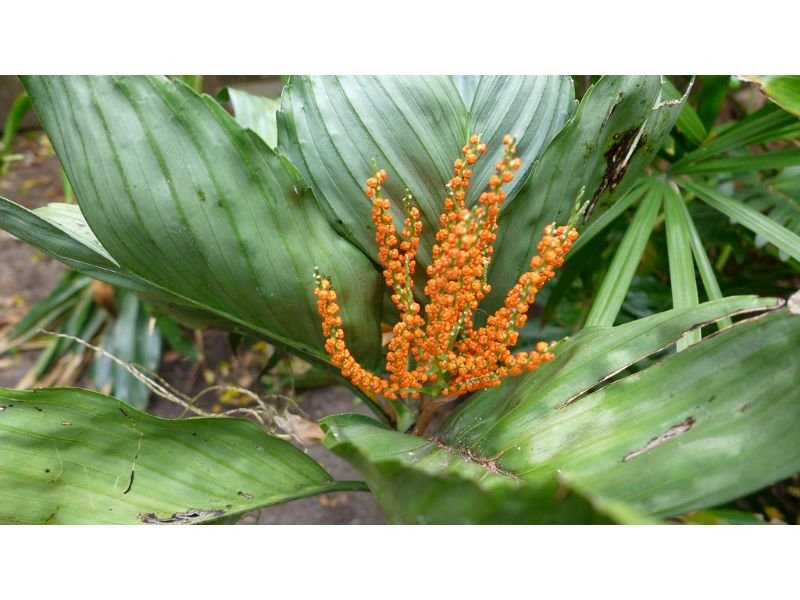
Chamaedorea metallica gets its name from its striking metallic-blue-green fronds. These fronds have a distinctive shape, resembling the tail of a fish, which adds an intriguing and decorative element to its overall look.
This palm typically grows to a manageable height of 2 to 4 feet (0.6 to 1.2 meters) indoors, making it well-suited for homes and offices with limited space. Outdoors, can reach slightly greater heights under optimal conditions.
These palms appreciate higher humidity levels, which can be especially important in dry indoor environments. Regular misting or the use of a humidity tray can help maintain adequate moisture levels.
While they make excellent indoor plants, Miniature Fishtail Palms can also be grown outdoors in suitable climates. They are adaptable to various garden settings and can be used in landscaping as accent plants, in container gardens, or as understory plants beneath taller trees.
Pygmy Date Palm (Phoenix roebelenii)
Pygmy date palm is a small palm that grows about 8-10 feet tall. It does best in full sun or part sun and can tolerate a little drought. Pygmy date palms make a great indoor plant and are easy to care for.
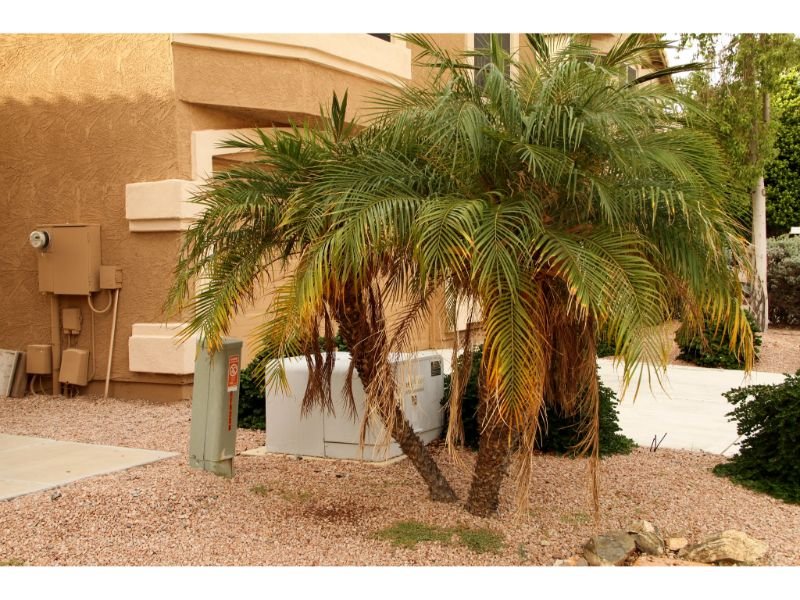
The mini version of this palm can grow in a pot or container indoors and is perfect for small spaces. It does best in bright, indirect light but can also tolerate low light. Water when the soil is dry to the touch and fertilizes monthly during the growing season.
If you’re looking for a mini palm tree to spruce up your indoor space, the Pygmy Date Palm is a great option. It’s easy to care for and can tolerate a wide range of lighting conditions, making it a versatile plant for any home.
Chamaedorea atrovirens
Chamaedorea atrovirens, commonly known as the Mexican Bamboo Palm or simply the Bamboo Palm, is a palm species native to Mexico and Central America.

Mexican Bamboo Palms are characterized by their elegant, feathery fronds that resemble bamboo leaves. These fronds are typically a rich, dark green color, adding a lush and tropical feel to any environment.
They are relatively small palms, typically reaching a height of 6 to 10 feet (1.8 to 3 meters) when grown outdoors. When used as an indoor plant, they tend to remain smaller, making them suitable for homes and offices with limited space.
These palms appreciate higher humidity levels, which is important to consider in dry indoor environments. Regular misting or placing a humidity tray nearby can help maintain the ideal moisture levels.
They are versatile and can be used as both indoor and outdoor plants. Outdoors, They are commonly used in landscaping as accent plants, hedges, or as part of tropical garden designs. Indoors, they add a touch of greenery and a tropical ambiance to living spaces.
Dwarf Sugar Palm (Arenga engleri)
The Dwarf Sugar Palm (Arenga engleri) is a compact and attractive palm species known for its ornamental qualities, cold tolerance, and versatility in various garden settings.

As the name suggests, the Dwarf Sugar Palm is relatively small compared to many other palm varieties, typically reaching a height of 6 to 10 feet (1.8 to 3 meters) in its mature form. Its moderate size makes it suitable for smaller gardens and landscape designs.
This palm is characterized by its gracefully arching, feather-like fronds with a lush, dark green color. The fronds emerge from a single trunk that is typically covered with attractive, diamond-shaped leaf bases, adding to its overall visual appeal.
One of the standout features of the Dwarf Sugar Palm is its remarkable cold tolerance. It can withstand colder temperatures than many other palm species, making it a suitable choice for regions with chilly winters.
This palm species is generally low-maintenance. Regularly removing dead or yellowing fronds and occasionally feeding with palm fertilizer can help promote healthy growth.
Dwarf Mountain Palm (Chamaedorea tuerckheimii)
As the name suggests, the Dwarf Mountain Palm is relatively small in size, typically growing to a height of 3 to 6 feet (0.9 to 1.8 meters). Its moderate size makes it suitable for indoor and outdoor spaces with limited room.
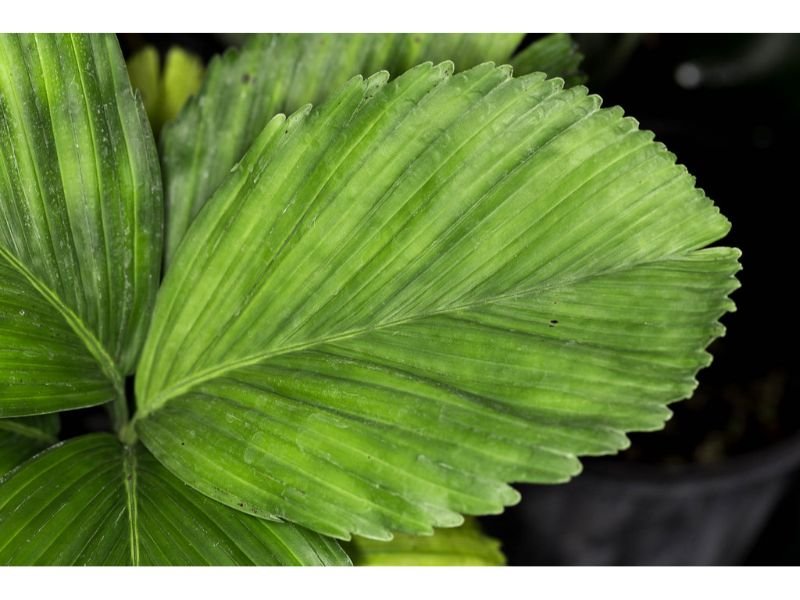
This palm is characterized by its attractive, pinnately compound leaves that form a feathery, bushy crown. The fronds are typically dark green, adding a touch of elegance and tropical beauty to any setting.
Dwarf Mountain Palms thrive in bright, indirect light but can tolerate lower light conditions, which makes them adaptable to indoor environments. They should be protected from direct sunlight, which can scorch their leaves.
They are versatile and can be used as both indoor and outdoor plants. Outdoors, they are often used as ornamental specimens, in container gardens, or as part of tropical landscape designs. Indoors, they can provide a tropical ambiance to living spaces.
Kentia Palm (Howea forsteriana)
The mini kentia palm is a popular indoor plant that is often used in offices and homes. It has a small, compact form that makes it perfect for tight spaces, and it requires very little care to keep it healthy. The mini kentia palm is also one of the most low-maintenance palms available, making it a great choice for busy people or those who are new to plant care.
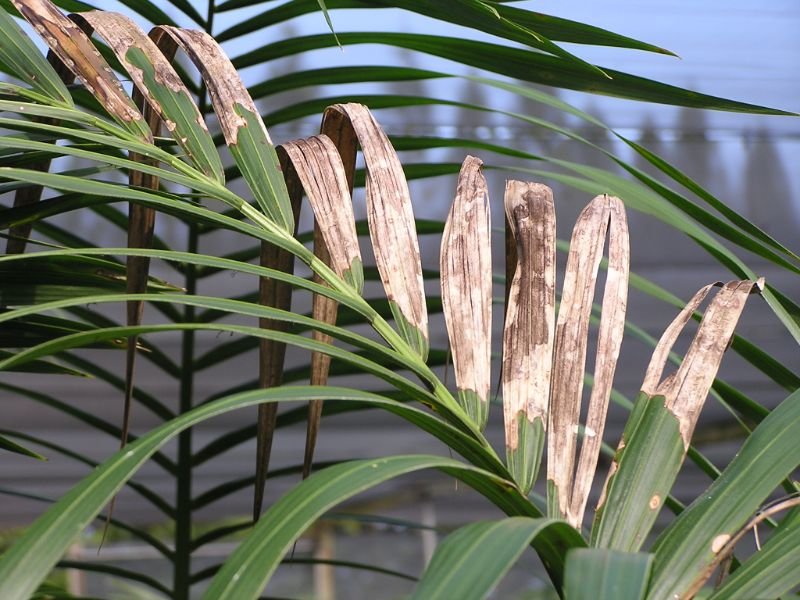
Kentia palms are native to Lord Howe Island off the coast of Australia, and they were first brought to Europe in the early 1800s. They quickly became popular indoor plants because of their exotic appearance and ability to thrive in cool, low-light conditions. Kentia palms are still widely available today, and they make an excellent choice for anyone looking for a low-maintenance houseplant.
Bottle Palm (Hyophorbe lagenicaulis)
The Bottle Palm (Hyophorbe lagenicaulis) is a distinctive and visually striking palm tree known for its unusual bottle-shaped trunk and elegant fronds.
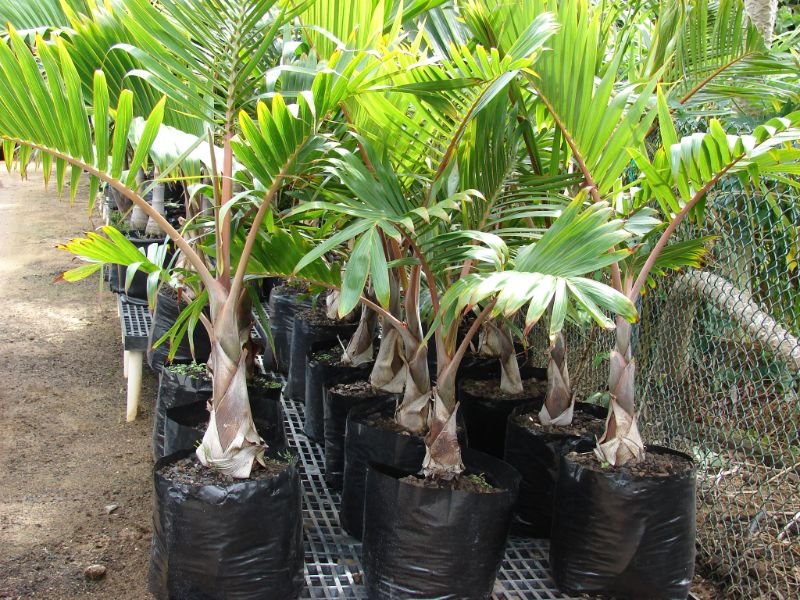
The most prominent and unique feature of the Bottle Palm is its swollen, bottle-shaped trunk. This swollen appearance occurs naturally and gives the palm its name. Over time, the trunk gradually elongates, but it retains a distinctive shape throughout its life.
The palm’s crown consists of pinnate fronds that arch gracefully, giving it an elegant and tropical appearance. The fronds are typically deep green and feathery, creating a lush and attractive display.
Bottle Palms are relatively small compared to many other palm species, typically reaching a height of 6 to 10 feet (1.8 to 3 meters) when mature. This compact size makes them suitable for smaller gardens and landscape designs.
Due to their small size and striking appearance, Bottle Palms are also suitable for container gardening. They can be grown in large pots on patios or in indoor spaces with adequate sunlight.
Can you keep palm trees indoors?
Yes, you can keep palm trees indoors. In fact, many people keep palm trees as indoor plants. If space is your problem then a mini palm tree is the answer. With correct potting and care, this dwarf palm tree can provide benefits as much as other houseplants.

Are palm trees good house plants?
Good houseplants come with some characteristics namely they should be able to filter the air, they should help increase humidity, and they can improve your mood and make you feel relaxed. Palm trees have all of these benefits which make them one of the best houseplants that you can get.
Uses and Benefits of Indoor Palms.
Indoor palms are popular houseplants because they add a touch of the tropics to any home décor. But these plants are not just pretty to look at – they come with a host of benefits as well.
Palm trees can help purify the air in your home by filtering out harmful toxins and chemicals. They also release moisture into the air, which can help to keep your skin and respiratory system healthy.
Another benefit of mini palm trees is that they can help to boost your mood and energy levels. The sight and smell of these plants can help to reduce stress and anxiety and increase feelings of happiness and well-being.
There are many small size palm trees that can grow well in the pot indoors. If you are planning to have one in your living room or maybe in your bedroom, the next part will focus on the complete list of mini indoor palm trees we recommend.
Points to Consider Before Growing Palms Indoors:
There are a few things to take into account before growing palm indoors.
Space: First, you need to make sure that you have enough space for your palm. A potted palm can grow up to 6 feet tall, so be sure to choose a spot that can accommodate its size.
Lighting: Palms prefer bright, indirect sunlight. If you don’t have a spot in your home that gets enough light, you can grow your palm under artificial lighting.
Temperature: Most palms thrive in warm temperatures, so be sure to keep your home’s temperature between 65 and 75 degrees Fahrenheit.
Humidity: Palms also prefer humid conditions, so you may need to mist your plant regularly or use a humidifier to increase the moisture in the air around your palm.
Water: Palms like to be kept moist, but not soggy. Be sure to water your palm when the top inch of soil is dry.
Fertilizer: Palms need to be fertilized about once a month during the growing season. Use a fertilizer that is high in nitrogen and low in phosphorus.
Pruning: Palms will need to be pruned occasionally to remove dead leaves and branches.
With proper care, your mini palm tree house plant will thrive indoors. Be sure to give it the space, light, humidity, and water it needs to grow.
A Quick Guide to Planting Palms Indoors.
1. Choose a pot. When choosing a pot for your palm, make sure to pick one that is large enough to accommodate the plant’s roots. The pot should also have drainage holes so that the soil can dry out between waterings.
2. Soil mix. For best results, use a soil mix specifically designed for houseplants. If you can’t find this, you can make your own by mixing equal parts potting soil, peat moss, and perlite.
3. Planting. Once you have your pot and soil mixed, it’s time to plant your palm! Gently remove the plant from its current pot, then loosen the roots before placing it in the new pot. Fill in around the roots with your soil mix, then water thoroughly.
4. Light and water. Palms need bright, indirect light to thrive. Water your palm when the top inch of soil is dry, being careful not to overwater.
5. Fertilizing. Feed your palm every month during the growing season (spring and summer) with a liquid fertilizer diluted to half-strength.
With proper care, your mini palm tree house plant will thrive indoors! Enjoy the beauty of this tropical plant in your home all year long.
Pruning mini indoor palm tree.
As your mini palm tree house plant grows, you may need to prune it to keep it looking its best. To do this, simply cut off any yellow or brown leaves with sharp scissors.
You can also remove any dead or dying fronds (the leaf-like structures that make up the palm’s canopy). If you want to encourage your palm to branch out, you can cut the main trunk just above a leaf node (the point where new leaves emerge). Be sure to use sharp, clean scissors when pruning your palm to avoid damaging the plant.
Propagation of mini palm tree.
Mini palm tree house plants can be propagated by seed, but it is more commonly done by division. Start by carefully removing the palm from its pot. Gently loosen the root ball and divide the plant into two or three sections, making sure that each section has a good amount of roots attached.
Re-pot each section into its own pot filled with fresh, well-draining potting mix. Water thoroughly and place in a bright spot. Keep the soil moist but not soggy until new growth appears. Once your palm is established, you can reduce watering to once or twice a week.
Give your mini palm tree house plant the occasional misting to help raise the humidity around it. This is especially important in winter when heaters can make indoor air quite dry. You can also place your palm on a pebble tray filled with water to help increase the humidity.
Repotting Mini palm tree.
As your mini palm tree house plant grows, it will eventually need to be repotted into a larger pot. Choose a pot that is only one or two sizes larger than the current pot. Be sure to use a well-draining potting mix and water thoroughly after repotting.
Repotting small palm trees is best done in spring or summer because it’s a time of active growth. However, you can report your palm at any time if necessary. Just be sure to give it plenty of water and a bright spot to help it recover from the stress of being moved.
Indoor Palm Trees: Common Pests and Diseases.
Plants just like other living things can also experience “sick” although they can’t say it of course. There are several indoor palm pests and diseases that could affect your plant. As a grower, it is important to be aware of these problems so you can take the necessary steps to prevent or solve them.
One of the common problems that could attack your indoor palm is mealybugs. These are small, white, wingless insects that love to feast on the sap of the plant. Mealybugs can be a big problem because they not only steal nutrients from the plant, but they also excrete a sticky substance called honeydew. This honeydew can then attract ants and other insects which could further damage your palm. If you see mealybugs on your indoor palm, you can remove them by wiping them off with a cotton swab dipped in rubbing alcohol.
Another common indoor palm pest is scale. Scale is small, hard-shelled insects that attach themselves to the stems and leaves of plants to suck out the sap. Like mealybugs, the scale can also excrete honeydew which can attract ants and other pests. Scale can be controlled by wiping them off with a cotton swab dipped in rubbing alcohol or by using a systemic insecticide.
Spider mites are another type of indoor palm pest that you should be on the lookout for. These tiny spider-like creatures are difficult to see with the naked eye but they can cause big problems for your palm. Spider mites feed on the sap of the plant and can quickly kill an indoor palm if left unchecked. These pests can be controlled by regularly spraying your palm with water or by using a miticide.
Indoor palms can also be affected by a number of diseases. One of the most common diseases is root rot which is caused by overwatering. Root rot can kill an indoor palm so it is important to make sure that you are not watering your palm too often. If you see that the leaves of your palm are wilting or turning yellow, this is a sign that your palm needs less water.
Another common disease is the brown spot which is caused by a fungus. Brown spot usually appears as brown or yellow spots on the leaves of the palm. If left untreated, this disease can spread to the stem and trunk of the palm and eventually kill the plant. Brown spots can be controlled by using a fungicide.
Pests and diseases can be a big problem for indoor palms but with proper care and treatment, they can be controlled. Be sure to inspect your palm regularly for signs of pests or disease and take action immediately if you see anything suspicious. By doing this, you can help keep your indoor palm healthy and looking its best.
Some related questions about mini palm tree houseplants:
How big do Mini palms get?
Miniature palm trees usually dwarf varieties of existing species. The height of a mini palm tree can vary considerably, depending on the specific variety. However, most mini palms only grow to between 3 and 6 feet tall. Some varieties may only top out at around 2 feet.
Putting your palm tree in a smaller pot won’t stop it from getting any taller. In fact, if the roots of your mini palm tree are constricted, this can actually cause the tree to stop growing altogether. If you want to keep your mini palm at a certain height, it’s best to prune it regularly.
Are Miniature Palm Trees Poisonous?
No, miniature palm trees are not poisonous. However, some varieties of palms can contain toxins that can be harmful to humans and animals if ingested. If you have concerns about a particular variety of palm, it’s best to check with your local Cooperative Extension office or a certified arborist.
When Are Miniature Palm Trees in Season?
Miniature palm trees are typically available year-round. However, the availability of specific varieties may vary depending on the time of year and your location.
How Often Should I Water My Mini Palm Tree?
It’s important to water your mini palm tree regularly to keep it healthy. However, how often you need to water will depend on a number of factors, including the type of palm you have, the size of the pot, the weather, and the humidity levels in your home. As a general rule of thumb, mini palm trees need to be watered about once a week. Be sure to check the soil before watering to make sure it is dry.
How Much Sun Does a Mini Palm Tree Need?
Most mini palm trees need a moderate amount of sunlight to thrive. However, there are some varieties that can tolerate lower light levels. If you’re not sure how much sun your mini palm needs, it’s best to check with your local Cooperative Extension office or a certified arborist.
How Do I Fertilize My Mini Palm Tree?
Fertilizing your mini palm tree is a great way to keep it healthy and promote growth. However, how often you need to fertilize will depend on the type of palm you have, the size of the pot, and the fertilizer you’re using. As a general rule of thumb, mini palm trees should be fertilized about once a month. Be sure to follow the instructions on the fertilizer label to ensure that you’re using the right amount.
Is a palm tree air purifier?
Yes, palm trees can help to purify the air in your home. They do this by trapping dust and other particles in their leaves and providing a natural source of negative ions. Negative ions are known to improve air quality and have a number of health benefits, including reducing stress levels and improving respiratory function.

Gardening is my passion and growing plants indoors has always been a stress relief for me. Grow a banana tree in my apartment once (although failed to produce bananas).





